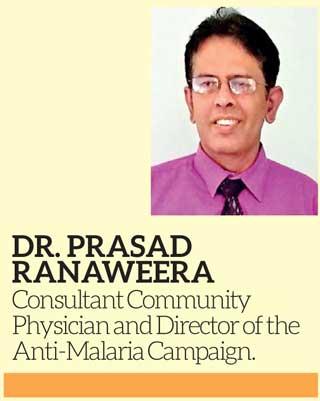23 Apr 2021 - {{hitsCtrl.values.hits}}

 During 1935-1936 Sri Lanka witnessed a surge of malaria cases with a large number of deaths. Malaria is a vector-borne disease caused by Anopheles culicifacies that breeds in a range of habitats from shallow water pools in rivers to shallow wells, swamps and rain water depressions.
During 1935-1936 Sri Lanka witnessed a surge of malaria cases with a large number of deaths. Malaria is a vector-borne disease caused by Anopheles culicifacies that breeds in a range of habitats from shallow water pools in rivers to shallow wells, swamps and rain water depressions.
“There was a time when the death rate was higher than the birth rate,” recalled Dr. Prasad Ranaweera, Consultant Community Physician and Director of the Anti-Malaria Campaign. “However, by 1952, the total number of deaths was below 1000 and by 1963 the numbers were reduced to 17 while the number of locally transmitted cases was just 11. With that, the matter was taken lightly and this resulted in a surge of cases after five years. By 1968 Sri Lanka had around 500,000 cases and it took another 45 years to reduce cases to zero,” said Dr. Ranaweera.
 The last recorded locally transmitted case was reported in 2012 while the last death due to malaria was reported in 2017. “Elimination is a huge achievement particularly because Sri Lanka is the first country to have eliminated malaria in this region. Sri Lanka received the malaria elimination certificated in 2016. Since 2012, we have taken every step to keep Sri Lanka malaria-free. Annually we get about 50 cases of malaria, but last year there were 30 cases and this year we have come across six cases. One of the unique features of the malaria elimination programme is that we have been able to stay malaria free despite having the mosquito,” the doctor said.
The last recorded locally transmitted case was reported in 2012 while the last death due to malaria was reported in 2017. “Elimination is a huge achievement particularly because Sri Lanka is the first country to have eliminated malaria in this region. Sri Lanka received the malaria elimination certificated in 2016. Since 2012, we have taken every step to keep Sri Lanka malaria-free. Annually we get about 50 cases of malaria, but last year there were 30 cases and this year we have come across six cases. One of the unique features of the malaria elimination programme is that we have been able to stay malaria free despite having the mosquito,” the doctor said.
A strategic surveillance system has been established to respond if a suspected case is identified. “Whenever cases are reported they are referred to the Anti-Malaria Campaign. We then get the blood samples. If negative we keep on checking until we are sure that the case is negative. The diagnosis is confirmed after conducting malaria laboratory investigations including microscopy, Rapid Diagnosis Test and PCR. Routine entomological and parasitological surveys are done by respective teams. Our aim is to treat the patient as early as possible. Free health services are available for Sri Lankans as well as tourists who are suspected or are diagnosed with malaria,” said Dr Ranaweera.
Sri Lanka’s Anti-Malaria Campaign doesn’t include insecticides to eliminate the mosquitoes. The density, behaviour, biting patterns and times of mosquitoes are being monitored. On the other hand, healthcare personnel are constantly trained and training is also conducted on private sector medical staff as well. “Patients are now being treated under consultant doctors. Even after their treatments are completed we monitor them for seven days, a month and ensure that they are fully recovered,” he said.
Since the global malaria fund has stopped funding from this year, the Government of Sri Lanka is now vested with the task of funding the Anti-Malaria Campaign. “A majority of cases are now being reported from African countries. Out of the thirty cases that were reported last year, five of them were from Uganda. On the other hand, local quarantine centres were established in highly malarious areas in the dry zone. Out of the 30 cases detected last year, 11 of them were from quarantine centres. Another high risk group comprises army personnel who are being sent for peacekeeping missions in Mali and Central Africa. People arriving from foreign countries should get themselves checked if they have signs of fever. They can go to the malaria laboratory and get a test done. This is another feature of our campaign. People also need to make doctors aware of their travel details. Even though the global theme is ‘Zero Malaria – Draw the line against Malaria’, the local theme is ‘Keep Sri Lanka Malaria free’,” he said in his concluding remarks.
Services at the Anti-Malaria Campaign are available 24/7 and contact 0117626626 for queries.
21 Dec 2024 2 hours ago
21 Dec 2024 3 hours ago
21 Dec 2024 4 hours ago
21 Dec 2024 7 hours ago
20 Dec 2024 20 Dec 2024